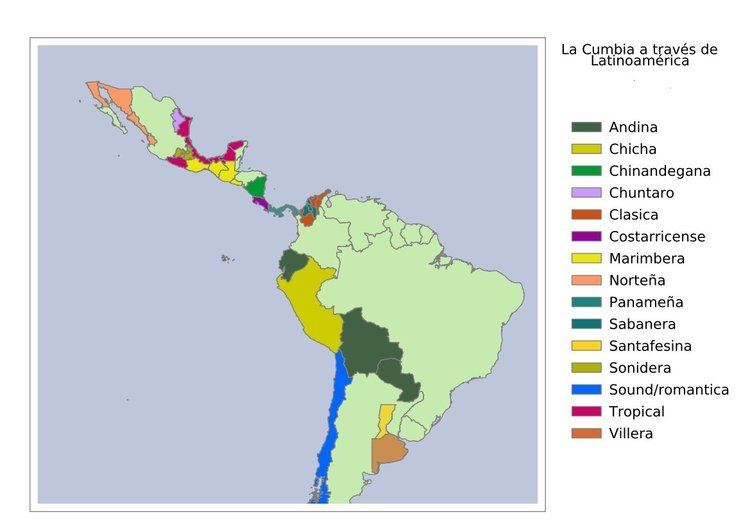 | ||
Stylistic origins West African, Amerindian and European music, steps and singing patterns. Typical instruments accordion, electric guitar, bass guitar, güira, timbales with cowbell and jam block, trumpet, trombone, saxophone, guitar, piano, sometimes drum kit | ||
Cumbia [ˈkumbja] is a dance-oriented music genre popular throughout Latin America. It began as a courtship dance practiced among the African population on the Caribbean coasts of Colombia and Panama. It later mixed with Amerindian and European instruments, steps and musical characteristics and spread throughout Latin America and abroad. While other genres of Latin American music have remained associated with specific countries or regions, cumbia has grown to be one of the most widespread and unifying musical genres to emerge from Latin America.
Contents
Colombia
By the 1940s Cumbia began spreading from the coast to other parts of Colombia alongside other costeña form of music like porro and vallenato. Clarinetist Lucho Bermúdez helped bring cumbia into the country's interior. By the 1950s cumbia was migrating across Colombia's northern and southern borders, first to Ecuador and Peru, then Mexico and Argentina, and eventually into the rest of Spanish-speaking Central and South America. The early spread of cumbia internationally was helped by the number of record companies located on the coast. Originally a working-class populist music, cumbia was frowned upon by the elites, but as the music pervaded class association with the music subsided in Colombia and cumbia became a shared music in every sector of society.
Today, the best representation of traditional Cumbia is shown every year on the Festival de la Cumbia in El Banco, Magdalena.
Ecuador
As Colombia's southern neighbor, Ecuador was among the first countries to adopt cumbia as a native genre. Ecuadorian cumbia initially drew heavily upon the Meztizo music of the Andes and gradually absorbed more Afro-Cuban instrumentation and rhythm throughout the 1960s and 70s.
Nicaragua
Nicaragua became a stronghold of Cumbia music during the 1950s and 1960s. The country has its own variation of cumbia music and dance.
Cumbia in the United States
Cumbia first came to the U.S. from Colombia and Central America in the mid-20th century and/or during the 1980s. Another wave of enthusiasm for and knowledge of the music arrived with the Colombian immigrants fleeing the turmoil of the 1980s. Since then, cumbia music scenes have grown up and thrived in U.S. cities within the significant Latin American populations of Los Angeles, New York, Chicago, and Corpus Christi. Cumbia music has also caught on with musicians beyond the Latina Diaspora, resulting in fusions of cumbia with other genres such as Afrobeat, punk rock, and brass band music.
